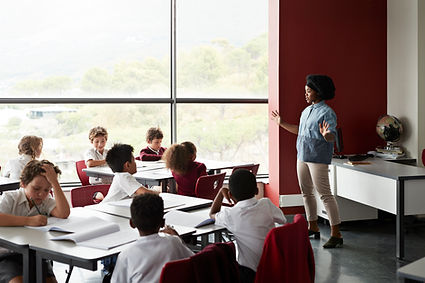
THE SCHINARAKIS
TEACHING & LEARNING PHILOSOPHY
The Schinarakis teaching and learning method seeks for a change in the scope of the
deaf child's education which should not be just imparting knowledge, but rather a change to foster the development of a student's personality.
FOSTERING EXCELLENCE.
CULTIVATING CRITICAL THINKING.
After working successfully with deaf students whose academic performance began poorly and was greatly improved through his pedagogical approach, George Schinarakis aimed to focus on why so many deaf students struggle with their academic achievements. While working with his students, he observed that when expectations were raised and critical thinking was integrated in constructive ways, all students were capable of further progress if motivated and if provided with learning opportunities appropriate to their communication needs.
George Schinarakis identified that the major challenges in deaf education are:
-
the stigma of low expectations
-
limited opportunities to develop critical thinking skills
-
learning environments in which they don't feel they belong
These three challenges, taken together, were the heart of the problem and the solution at the same time. Inspired by his students and his belief that all deaf students can learn at the highest level,
he developed his teaching and learning approach that gives Deaf students the opportunity to:
-
high expectations supported by strong academic standards
-
build critical thinking skills
-
understand that learning is a living, ongoing process


OVERVIEW.
George Schinarakis' teaching and learning method emphasizes the role of philosophy in Deaf education. Deeply influenced by the Socratic pedagogical approach, Schinarakis' method takes inspiration from techniques such as the Socratic irony, dialectic questioning, and maieutic. With the application of the Socratic techniques, the Schinarakis method aims not to teach the students, but rather to encourage students to explore questions that challenge their ideas and beliefs.
The Schinarakis method seeks to change the scope of the deaf child's education, which should not be just imparting knowledge, but rather a change to foster the development of the whole person.
The Schinarakis approach encourages a classroom environment characterized by "productive discomfort", where students learn how to overcome discomfort by staying engaged in the learning process. By promoting discomfort in appropriate, inclusive ways and with support, students learn how to plan for their future success and cope with the many challenges of growing up.
The main principle in the learning process is “learning how to learn,” and this is the foundation of the Schinarakis method. Deaf students undertake an active role in their learning and achieve the maximum development of their skills and abilities. The success of the Schinarakis method comes from an emphasis on the all-round student’s development by supporting them to learn how to:
-
explore their strengths and weaknesses
-
set challenges
-
connect learning and knowledge to real-life experiences
-
experience a constant sense of self-purpose and well-being
THE
STUDENT
The Schinarakis method puts an emphasis on the all-round student’s development. Students are equipped with the skills, tools, and experiences needed to maximize the quality of their knowledge and thinking.
In the Schinarakis method, the students are urged to:
-
build confidence, knowledge, and understanding
-
become active learners, teachers, and scientists
-
be flexible thinkers
-
become self-disciplined
-
learn from failure
-
set new challenges
-
embrace discomfort as a positive experience
-
pave the way for the young generations
THE
TEACHER
The quality of teachers is the most important factor in deaf students' success. With the right training and support, teachers believe that all deaf students can excel. They use their classrooms as labs where Deaf students are challenged to think deeply, explore ideas, and develop curiosity through a rich, supportive, and dynamic learning environment.
Successful teachers share several characteristics, including:
-
passion for teaching deaf students
-
love for children
-
excellent knowledge of how sign and spoken/written national languages work; focus on engaging students in authentic interactions
-
have high expectations for their students but even higher expectations for themselves
-
they use their failures and successes as opportunities to grow

THE
CLASSROOM
We believe that all deaf students can excel as learners and as citizens when provided with a rich, supportive, and dynamic educational environment.
The classroom environment has a profound impact on students’ behavior and their academic outcomes. The Schinarakis teaching and learning philosophy encourages a classroom environment that is unique and creative. A place that inspires the students to do their best. Teachers create a safe place in which deaf students feel comfortable to share their thoughts and ideas, take risks, explore concepts, and ask questions.
While creating a safe environment for students is essential, it is also equally important that deaf students feel challenged and excited to explore new concepts, understand new ideas, take risks, and make mistakes. For this, the Schinarakis' classroom is characterized by "productive discomfort". This balance is achieved through what George calls “productive discomfort.” Students are encouraged to step
out of their comfort zone and be introduced to unfamiliar texts, topics, and situations while staying engaged in the learning process.
Learning how to be challenged and what to do when challenged, can be overwhelming and confusing. By promoting discomfort in appropriate, inclusive ways, and with support, deaf students experience a constant sense of self-purpose and well-being. By giving deaf students the opportunity to discover how to examine issues in-depth, we create the need to learn how to plan for their future success and navigate the many challenges of growing up.
Core principles of an effective classroom include:
-
a sense of respect
-
safety
-
building trust
-
flexibility
-
engagement and humor
-
a sense of belonging